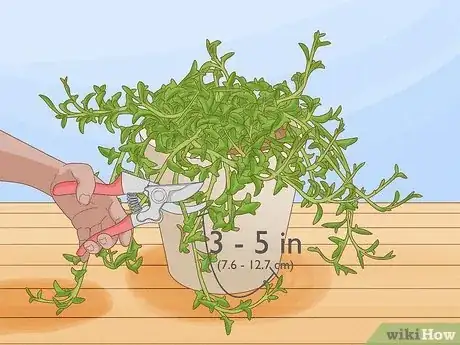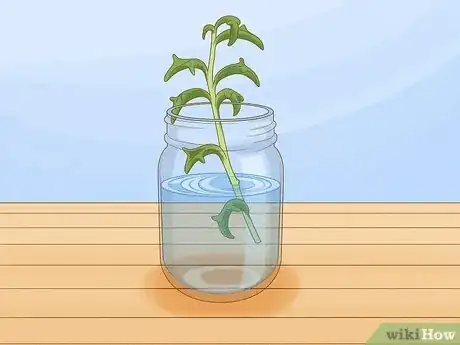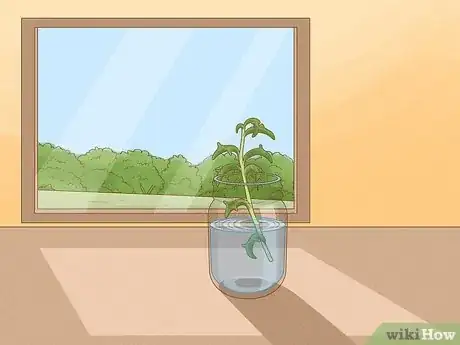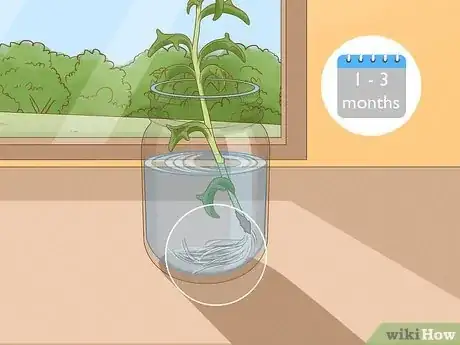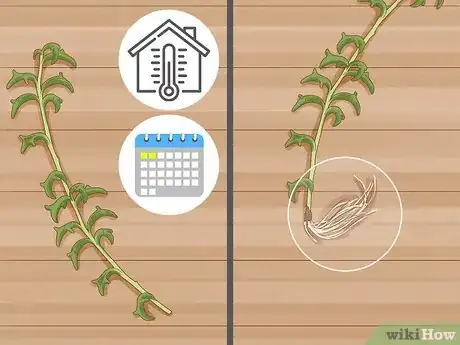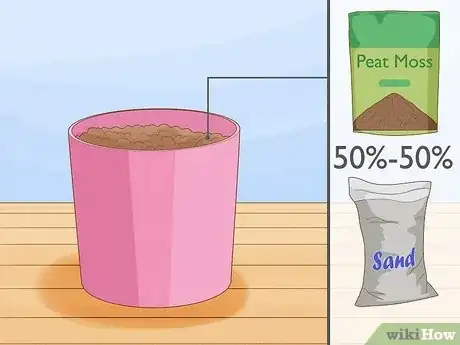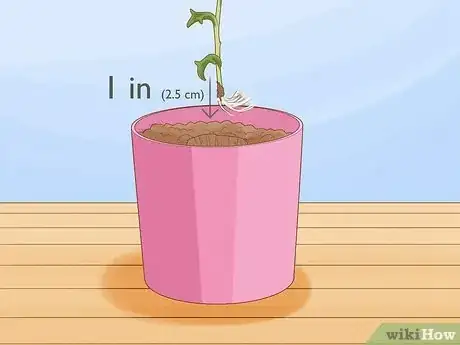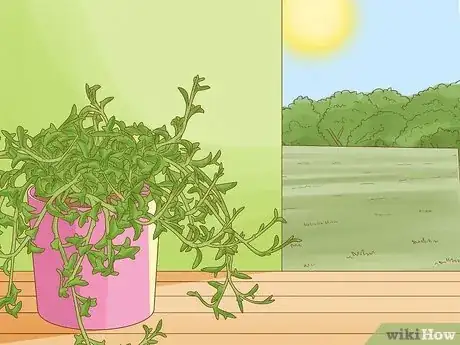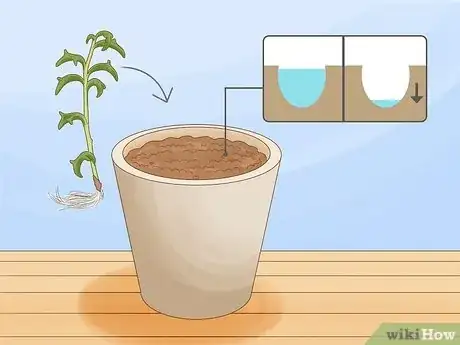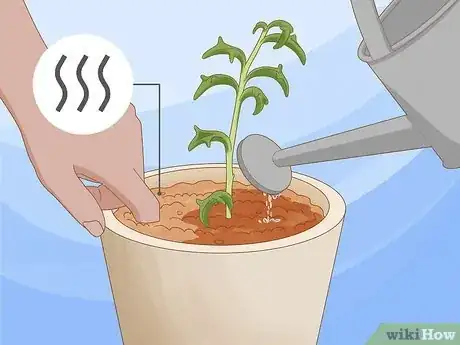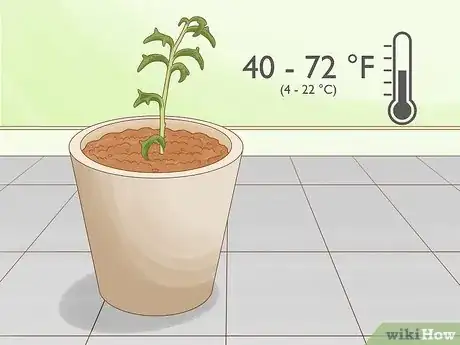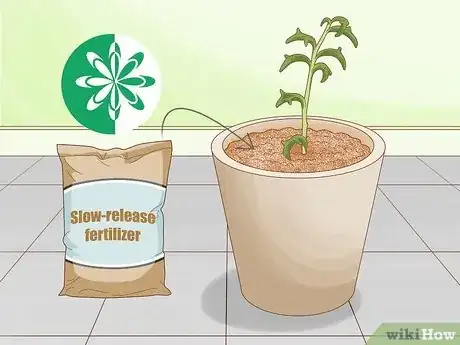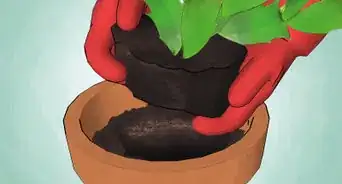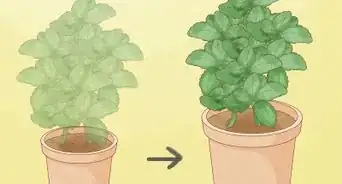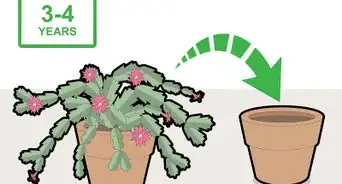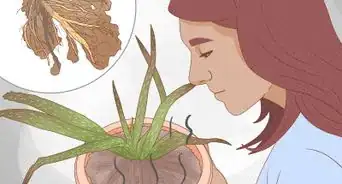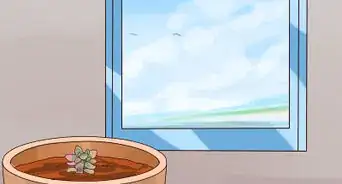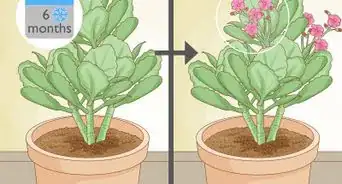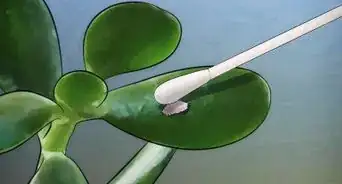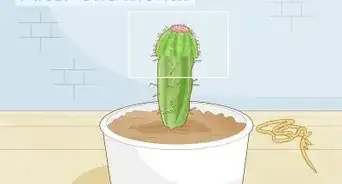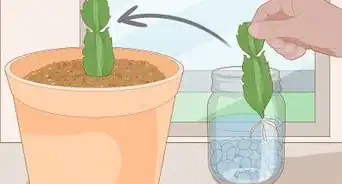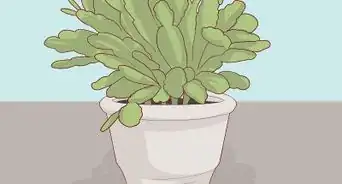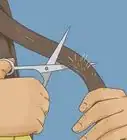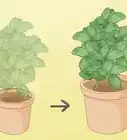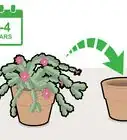This article was co-authored by Jon Rowland and by wikiHow staff writer, Hannah Madden. Jon Rowland is a Plant Specialist and the Founder of the Green House Center blog. With over eight years of plant and garden experience, he specializes in greenhouse care, lawn and garden maintenance, and home appliance recommendations. Jon aims to share his knowledge so that others can live a more convenient, efficient, and environmentally friendly lifestyle.
There are 11 references cited in this article, which can be found at the bottom of the page.
This article has been viewed 3,045 times.
You love your string of dolphins plant—and what’s not to love? This bouncy, beautiful succulent truly brightens up any room, so it’s no surprise you’d want to propagate new ones for yourself or for friends. Fortunately, whether you’re an expert gardener or new to having a green thumb, propagating a string of dolphins is a breeze. Choose between water propagation or soil propagation, and read up on our general care tips to keep your plant looking great.
Things You Should Know
- To propagate your plant in water, cut a piece off and place it in a glass jar. Once it grows roots, transfer it to a pot with soil.
- To propagate your plant in soil, cut a piece off and let it dry for about 2 days. Plant your cutting in a pot with potting soil.
- Keep your string of dolphins out of direct sunlight, and plant it in a well-draining soil.
- Water your string of dolphins once a week, and add fertilizer every spring.
Steps
Water Propagation
-
1Cut a 3 to 5 in (7.6 to 12.7 cm) piece from your plant. String of dolphin plants are fairly hardy, and they don’t need a very long cutting to start growing again. Clean your scissors thoroughly before starting, then find a root node and cut just above that spot.[1]
- Root nodes are the small, purplish bumps on the sides of the stem next to the leaves. Giving yourself a root node will speed up the propagation process.
-
2Place the piece in a glass jar with water. Fill up a glass jar with distilled or filtered water. Then, place the cutting inside the jar with the cut side in the water.[2]
- Always use distilled or filtered water, as straight tap water can have chlorine in it that could harm your cutting.
- Using a glass jar lets you keep an eye on the root growth.
- While you can replace the water if it looks dirty or cloudy, it’s not strictly necessary.[3]
Advertisement -
3Keep your jar in indirect light. A west-facing window is the perfect spot to put your cutting, since it will get indirect light without burning. String of dolphin plants grow best in indirect lighting, as too much sunlight may cause them to dry up.[4]
-
4Wait 1 to 3 months for the cutting to grow roots. String of dolphin plants are fairly slow growers, so you may have to wait a while before you see much growth. When the cutting has small, white roots that are a little over 1 in (2.5 cm) long, you can move on to the next step.[5]
-
5Transfer the cutting into soil. Once your cutting has enough roots, it’s ready to be planted! Fill a pot with well-draining soil, then place the cutting in the center of it. Cover the roots with soil and water your plant to set it up for success.[6]
Soil Propagation
-
1Cut a 6 to 12 in (15 to 30 cm) piece from your plant. Use clean, sterilized scissors to snip a piece off of your plant. Try to snip just above a root node, or the purplish bump on the side of the stem.[7]
- Getting a root node isn’t 100% necessary, but it will give your cutting a better chance of success.
-
2Let the piece dry out for about 2 days. Set your cutting on a flat, dry spot where it won’t be moved around. Leave it at room temperature for about 2 days to let the bottom of the cutting develop a callus.[8]
- Not letting your cutting dry out before planting could lead to root rot.
- After your cutting is dry, you can dip it in a rooting hormone if you’d like to. Rooting hormone isn’t totally necessary, but it does give your cutting a higher chance of developing strong roots.
-
3Fill a small pot with potting soil. Pick a pot with a drainage hole. Fill it up to the top with well-draining potting soil to let the water drain through.[9]
- Look for a mixture that’s about 50% sand and 50% peat moss or compost.
- Using potting soil that’s too dense can lead to root rot, which could kill your propagation.
-
4Plant the cutting in soil. Remember that pot you filled up earlier? Now’s the time to use it! Bury the bottom 1 in (2.5 cm) or so of the cutting in the center of the soil, then water your cutting.[10]
- Your cutting will start growing in about 1 month or so. Keep it in indirect light so it doesn’t burn.
- Give your cutting water every time the soil dries out (usually once a week or so).
General Care
-
1Keep your plant out of direct sunlight. String of dolphin plants thrive in indirect sunlight where they won’t get burned. Even after your cuttings have grown into full plants, keep them out of direct light for best results.[11]
- Try placing them near a west-facing window to get sun without burning.
-
2Plant your string of dolphins in well-draining soil. Dense soil that traps water isn’t good for string of dolphin plants, because it can lead to root rot. Instead, pick out a potting soil that’s made for succulents or cactuses, since it will be well-draining enough.[12]
-
3Water your plant when the soil dries out. String of dolphin plants are technically succulents, so they don’t need to be watered every day. Instead, plan on watering them once a week, or whenever the soil is dry. Over-watering could lead to root rot, so it’s important to keep an eye on this aspect of plant care.[13]
- Not sure if the soil is dry yet? Stick your finger about 1 in (2.5 cm) into the soil. If there is no dirt on your finger, then your soil is dry, and it needs to be watered. If there is dirt on your finger, your soil is still wet, and it doesn’t need to be watered.
-
4Keep the temperature between 40 and 72 °F (4 and 22 °C). String of dolphin plants are mostly indoor plants, because they don’t do well in harsh temperatures. If you are going to keep your plant outside, bring it in during the cold winter months and the hot summer months.[14]
- Your plant likely won’t survive a frost, because succulents don’t do well in freezing temperatures.
-
5Encourage growth with fertilizer in the spring. A balanced fertilizer helps your plant sprout new stems. Sprinkle a balanced, slow-release fertilizer onto the top of your potting soil every spring to help your string of dolphins thrive.[15]
- Fertilizer isn’t totally necessary, but it’s a great boost for a plant that’s looking a little lackluster.
-
6Kill pests with isopropyl alcohol. String of dolphin plants don’t often deal with bugs or insects, but you may see mealybugs hanging out in your plant from time to time. If that’s the case, fill a spray bottle with isopropyl alcohol, then spray your plant once a day. You can stop using the isopropyl once you don’t see any more bugs.[16]
- Mealybugs look white and cottony. They’ll often hang out on the underside of the plant near the soil.
Expert Q&A
-
QuestionWhat essentials are required for propagating plants?
 Jon RowlandJon Rowland is a Plant Specialist and the Founder of the Green House Center blog. With over eight years of plant and garden experience, he specializes in greenhouse care, lawn and garden maintenance, and home appliance recommendations. Jon aims to share his knowledge so that others can live a more convenient, efficient, and environmentally friendly lifestyle.
Jon RowlandJon Rowland is a Plant Specialist and the Founder of the Green House Center blog. With over eight years of plant and garden experience, he specializes in greenhouse care, lawn and garden maintenance, and home appliance recommendations. Jon aims to share his knowledge so that others can live a more convenient, efficient, and environmentally friendly lifestyle.
Plant Specialist The essentials are a pair of clippers, a sharp knife, and a pair of gloves. However, it depends on the propagation methods you’re about to use.
The essentials are a pair of clippers, a sharp knife, and a pair of gloves. However, it depends on the propagation methods you’re about to use.
References
- ↑ https://www.succulent.care/guides/propagation/
- ↑ https://www.youtube.com/watch?v=V_b5gyY3Tx8&t=159s
- ↑ https://www.missouribotanicalgarden.org/gardens-gardening/your-garden/help-for-the-home-gardener/advice-tips-resources/visual-guides/rooting-cuttings-in-water
- ↑ https://www.essentialhomeandgarden.com/string-of-dolphins/
- ↑ https://www.essentialhomeandgarden.com/string-of-dolphins/
- ↑ https://www.youtube.com/watch?v=V_b5gyY3Tx8&t=370s
- ↑ https://www.youtube.com/watch?v=e_THOX7Xk1E&t=340s
- ↑ https://www.youtube.com/watch?v=e_THOX7Xk1E&t=340s
- ↑ https://www.essentialhomeandgarden.com/string-of-dolphins/
- ↑ https://www.essentialhomeandgarden.com/string-of-dolphins/
- ↑ https://thestarvingfoster.com/dolphin-succulent/
- ↑ https://www.youtube.com/watch?v=e_THOX7Xk1E&t=195s
- ↑ https://homeandgardendigest.com/string-of-dolphins-senecio-peregrinus/
- ↑ https://thestarvingfoster.com/dolphin-succulent/
- ↑ https://www.youtube.com/watch?v=kgbmbEEd8QE&t=547s
- ↑ https://www.youtube.com/watch?v=e_THOX7Xk1E&t=295s
